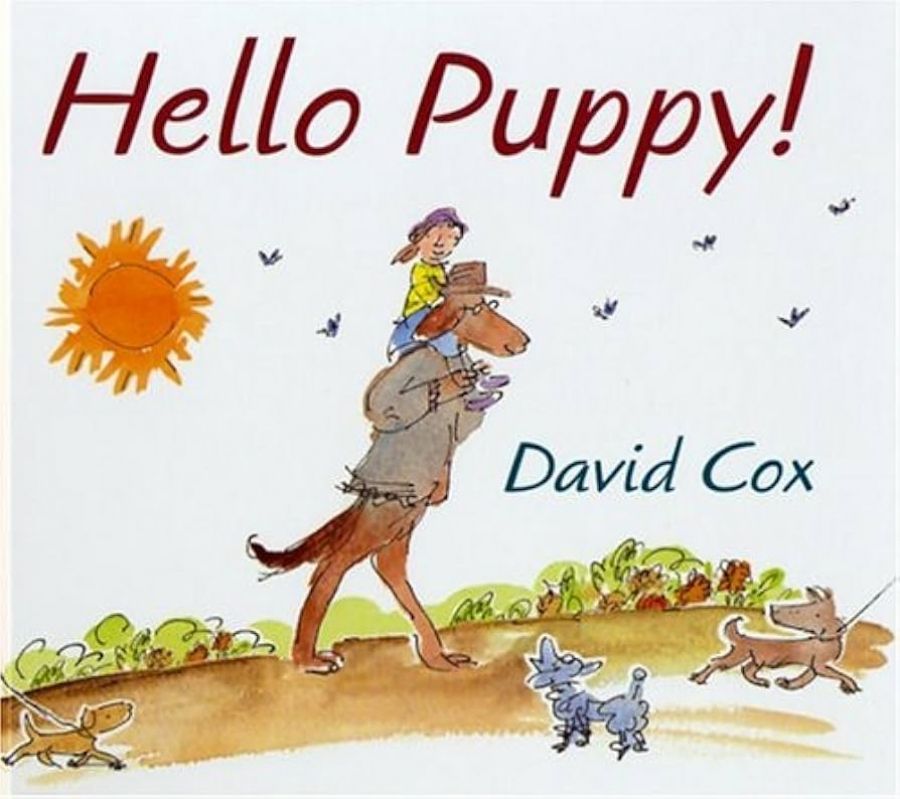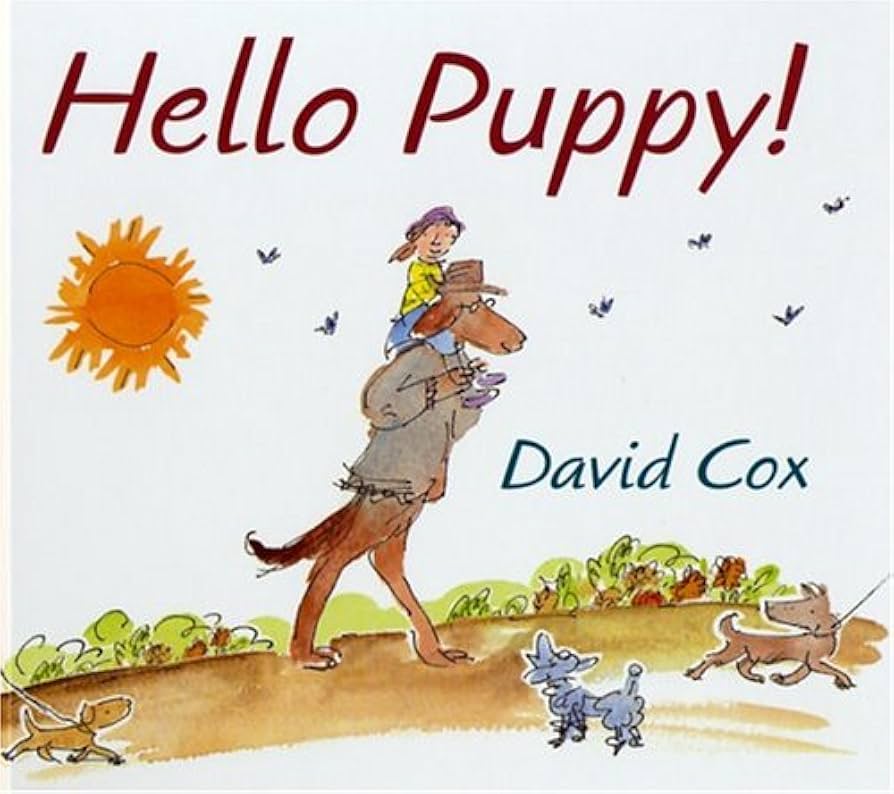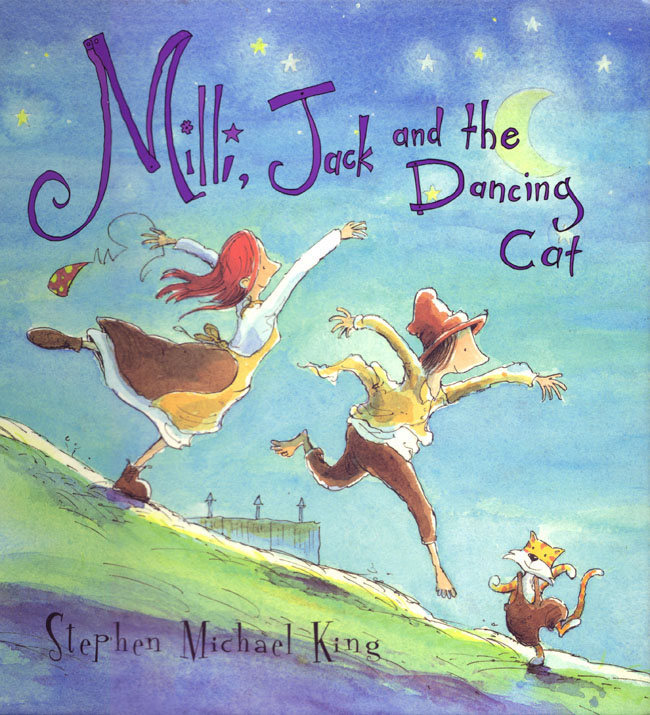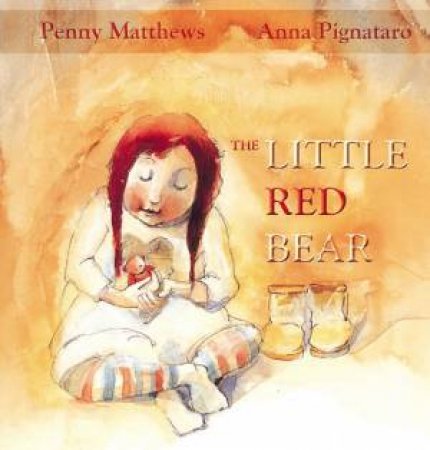
- Free Article: No
- Contents Category: Children's Fiction
- Custom Article Title: Virginia Lowe reviews Six Children's Fiction Books
- Review Article: Yes
- Article Title: Ways of Seeing
- Online Only: No
- Custom Highlight Text:
Imaginative grandfathers and European cityscapes dominate in these books, with all the protagonists having creative ways of seeing, just like their creators. When Suzy, in Grandpa’s Gate, falls down the thirteen steps from her house, what is needed is a gate for the top. So Grandpa welds a special one, with an owl, a moon and stars – ‘all sorts of extraordinary bits of his own’. It’s practical, but interesting at the same time. Then Suzy and her family move away and don’t see Grandpa for years, until, lonely and confused, he comes to live with them. But Suzy has an idea: in the garage is her old gate. Together, she and Grandpa paint, rehang and weld more birds to go with it.
- Book 1 Title: Hello Puppy!
- Book 1 Biblio: Penguin, $24.95 hb, 32 pp
- Book 1 Cover Small (400 x 600):

- Book 1 Cover (800 x 1200):

- Book 2 Title: Milli, Jack and the Dancing Cat
- Book 2 Biblio: Allen & Unwin, $24.95 hb, 32 pp
- Book 2 Cover Small (400 x 600):

- Book 2 Cover (800 x 1200):

- Book 3 Title: Little Red Bear
- Book 3 Biblio: Scholastic, $27.95 hb, 32 pp
- Book 3 Cover Small (400 x 600):

- Book 3 Cover (800 x 1200):

Conversely, in Milli, Jack and the Dancing Cat, Milli makes beautiful but completely impractical things in which no one in her town is interested. They only want ‘ordinary, practical, familiar things’. Milli must content herself with making them dull shoes: that is, until two ‘vagabond minstrels’ come to town – Jack and the Dancing Cat. They soon see what Milli is capable of, and teach her to dance. Eventually, Jack and the Dancing Cat ride off on their fantastically repaired bicycle, adorned with Milli’s gifts, returning from time to time to have a cup of tea with her.
Visually, these two books couldn’t be more different. Stephen Michael King’s odd little people are carefree and winsome. Susy Boyer’s pictures are extremely realistic, almost photographic; the only flights of fantasy are Grandpa’s joyous creations. But they’re saying the same thing: creative people are redeemed by their creations, however outlandish, and their creations can change their worlds. They just see differently from others.
Milli’s town could be anywhere. Her own house is a wide-verandahed Australian one, but the rest of the town looks European. The worlds of the two books illustrated by Anna Pignataro are definitely of the Old World. The buildings, weather and street scenes point to the northern hemisphere. Little Red Bear is set in a city, and the buildings and streets play a big part in it. In Loni and the Moon, the moon is one of the main characters, along with Loni. Buildings hardly count, though Loni’s room has a broad window sill decorated and made safe with ironwork, and his house has pantiles.
This is a warm and affectionate book. Loni remembers his love for his dog and his little brother, his house and his tomato plants. It also, like Hello Puppy, raises the issue of what is real, and what is pretence. We would all assume, along with Loni’s parents, that his visit to the moon was a dream, but where did Loni hear the story of the night of his birth? His parents have never told him. Birth is rarely mentioned in picture books, and it is a delight here to feel the joy of it. We see mum’s huge stomach as she labours, then her contented smile as she sleeps in the moonlight beside the tiny, wide-eyed Loni. On some pages, a small portion of the illustration is repeated near the text. It can be quite a puzzle tracking it down – another nice little mystery about seeing.
Anna Pignataro also illustrates Little Red Bear. In this, Hanna sees the bear while walking with her mother. She frets about it being lonely and exposed to the weather. Eventually, on a rainy, windy day, Hanna can endure it no longer and sets off to find the bear. After locating it, she returns to her worried mother. Hanna explains ‘I went to get the bear. He needed to be found.’ While she is drying out in front of the fire, her mother reassures her: ‘If you were lost I would go to the ends of the earth to find you.’ This is a beautiful story, warm and secure for Hanna and for the listener. There are delightful details to follow up in the pictures: dogs, pieces of paper sporting musical notes, elements of collage pasted on. It does, however, have one major problem. Red Bear is seen first on the corner of an office building: the left corner of the balcony wall. On the next opening, as they are still walking away, he is on the right front corner. The park and Hanna’s scarf have changed sides. I am sure it is not the experienced Pignataro who has made this mistake. I think that the page designer must have decided that the two people were walking in the wrong direction and reversed the first picture.
Enough is Enough is the most European of all. It looks like Italy with the pantiled roofs, church cupola and outdoor market, but there is an extra dimension. Not only do Henry, Zoë and their cat, Balthus, move to another country, but Henry can’t speak the language, either. He buys whatever food he’s given at the market, as he can’t make himself understood. But it all works out for the best, as the food he drops on the staircase is collected by all the other tenants. They join him in preparing a huge feast – no language, but instant friends. Balthus is delightful, as are the myriad other cats on every page, often quite difficult to spot. Children will enjoy the endpapers: at the front are plates laden with food, at the back, empty ones – only parsley and crumbs remain.
In David Cox’s Hello Puppy, four-year-old Bridie wants a puppy, but her mother says it would dig up the garden. Bridie creeps in next door, says ‘Hello, puppy’ to her grandfather, and works some magic: he becomes a large, partly clothed dog, walking on his hind legs. ‘He was a good puppy. He never dug up seedlings in the garden. He never growled or snapped or chased the cat.’ In fact, the puppy seems to act like the grandfather, even buying them both ice creams. Next birthday, Bridie visits him again: ‘But this time, she says, “Hello Grandad… Look what I’ve got!”‘, and he turns back into a person. Like Suzy’s Grandpa, he does what she wants. As in Loni and the Moon, the whole question of reality and illusion is broached, and here it is left delightfully up in the air. Did Bridie imagine it? Did Grandad pretend it? Or did it really happen in the story? It all depends on how you see.


Comments powered by CComment